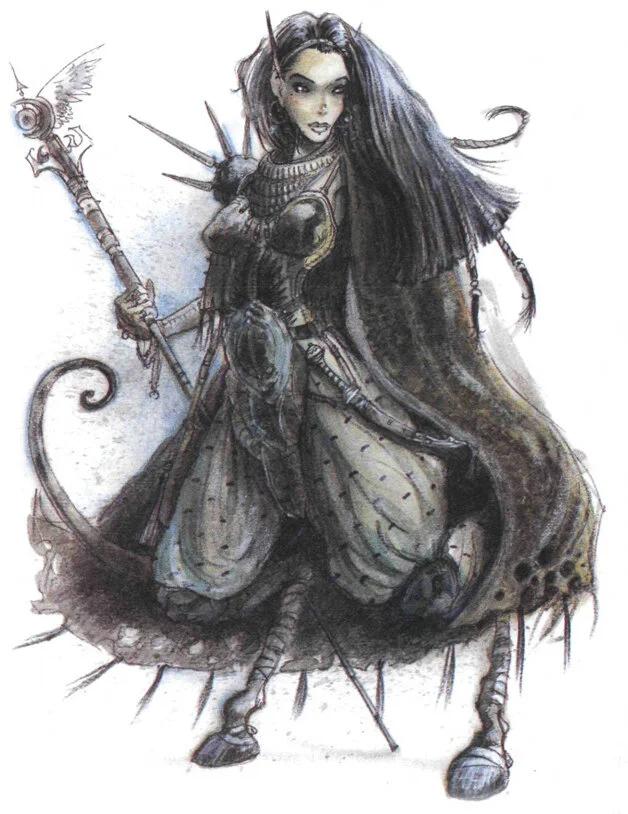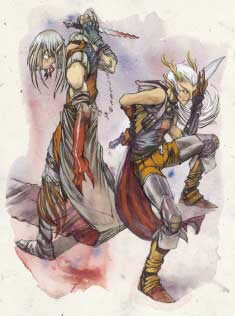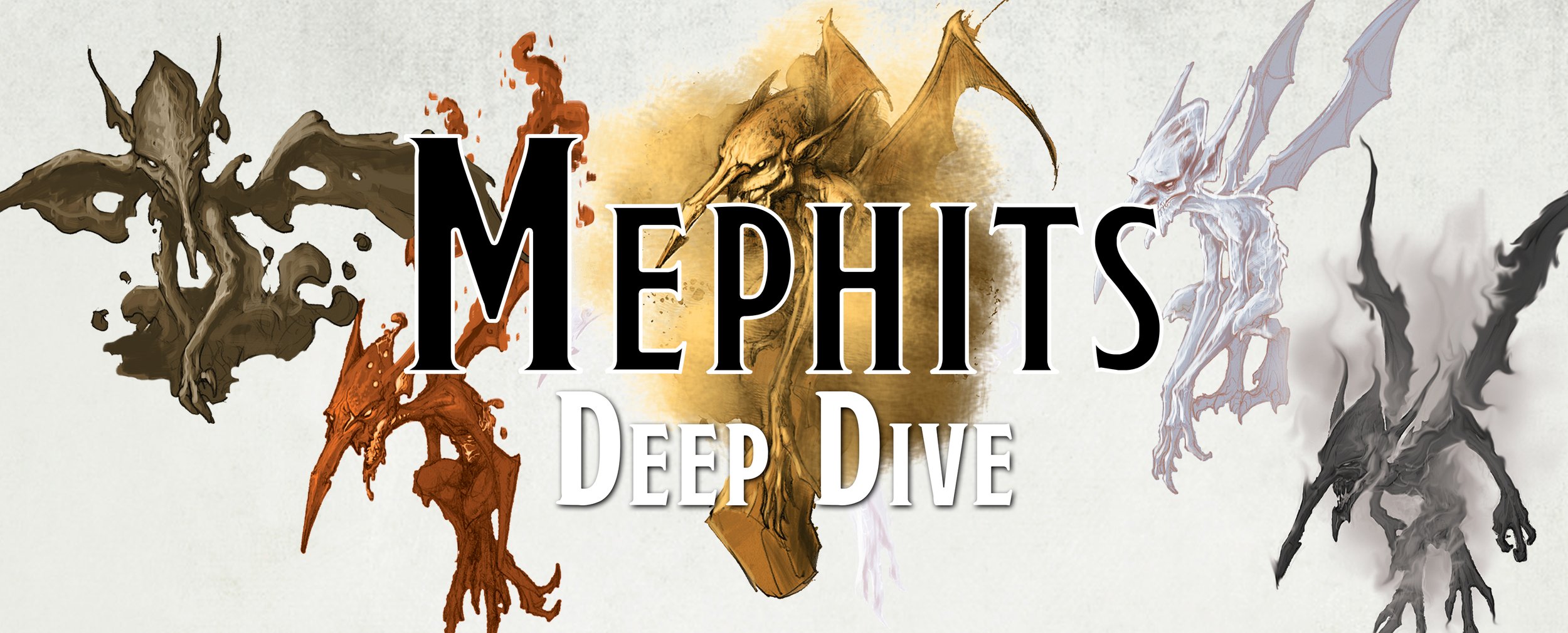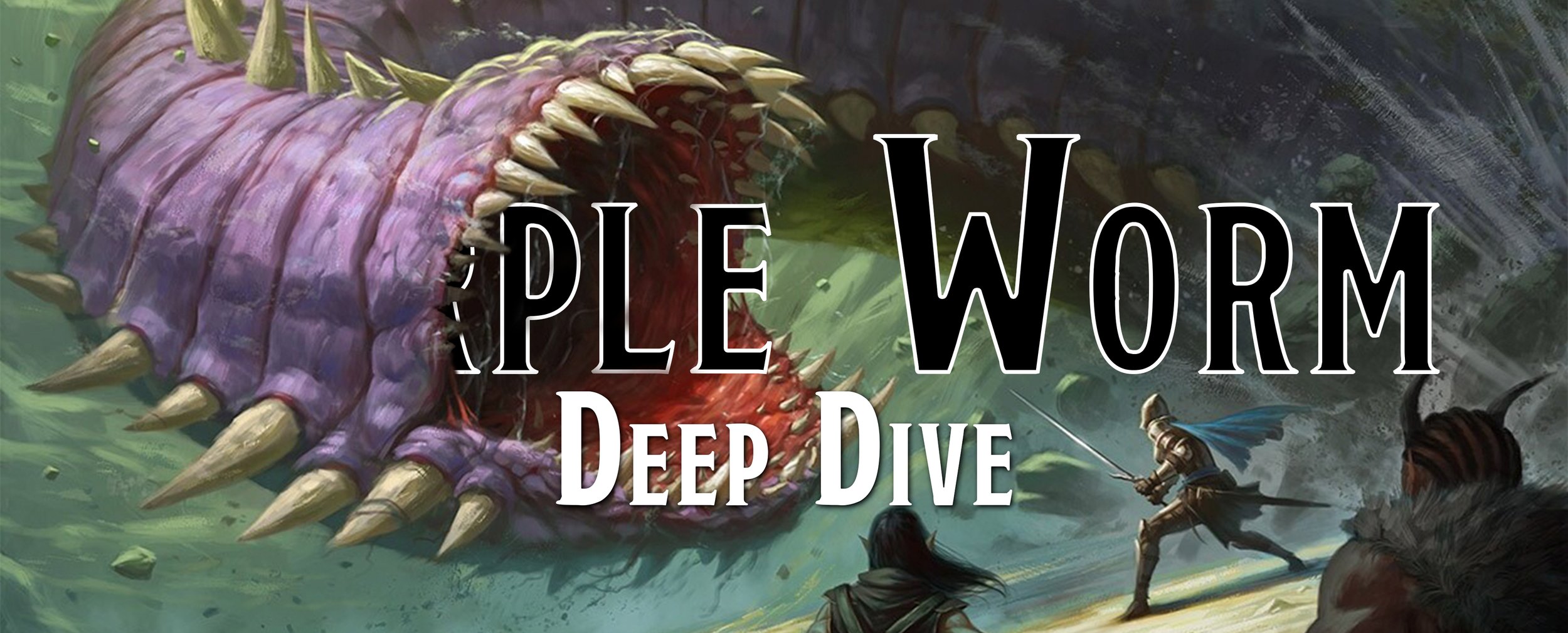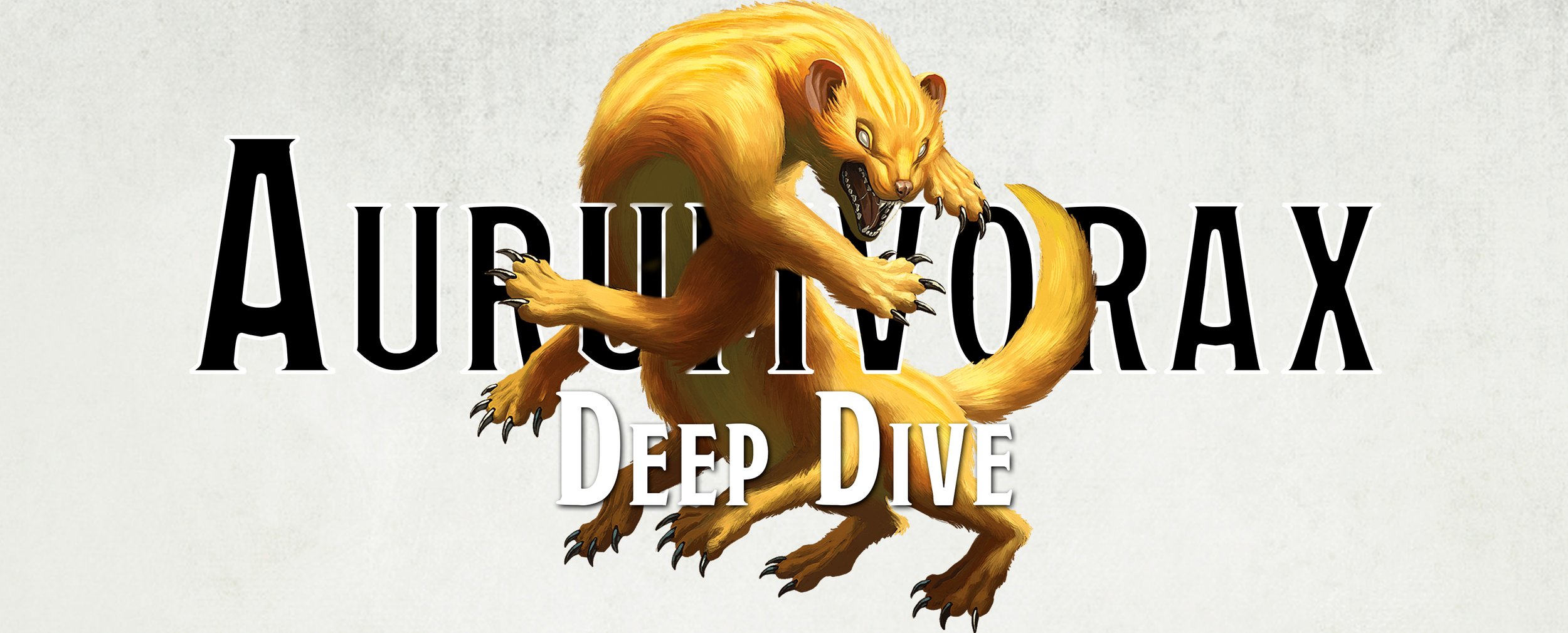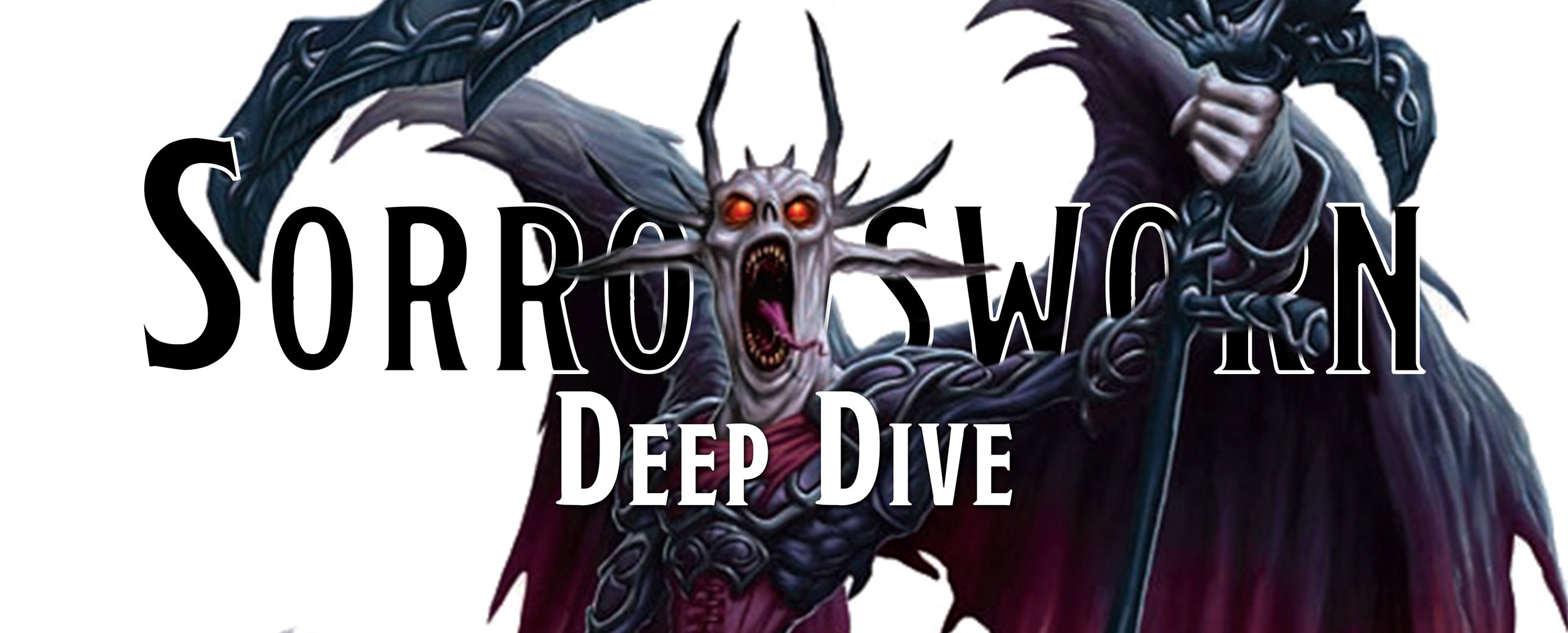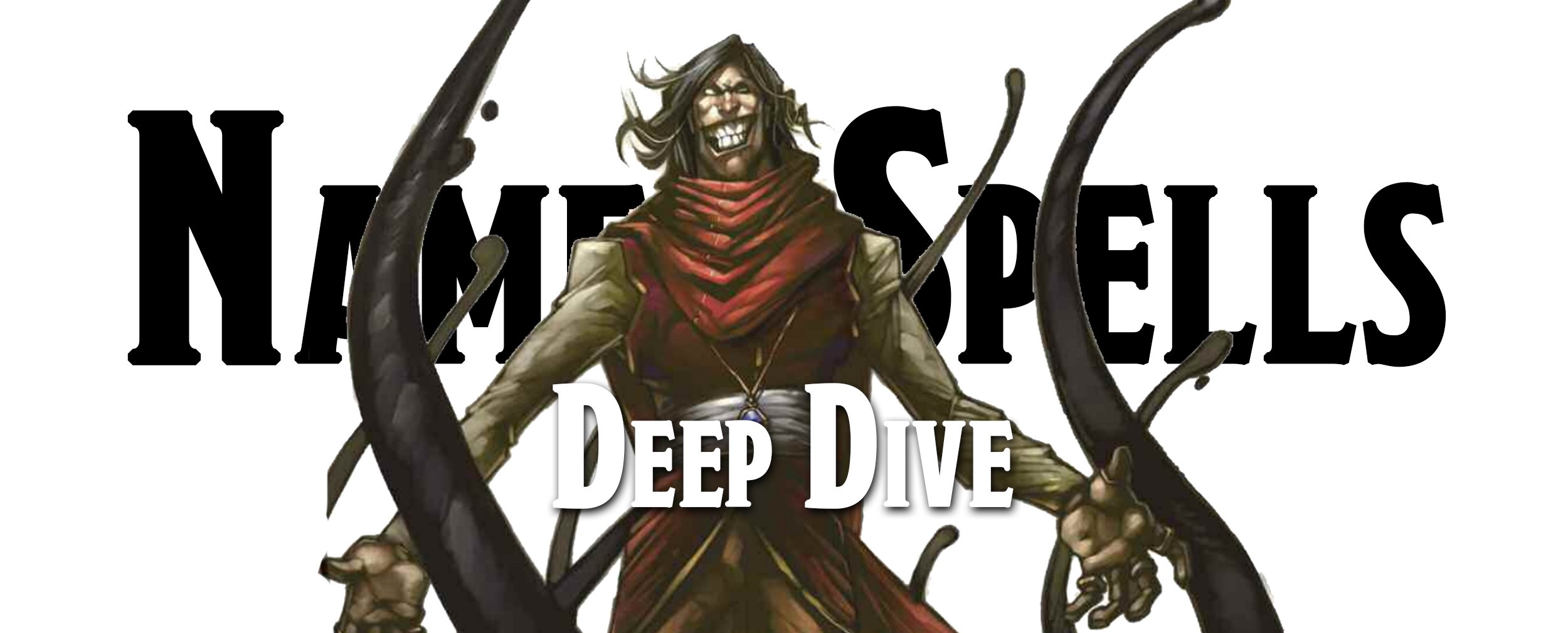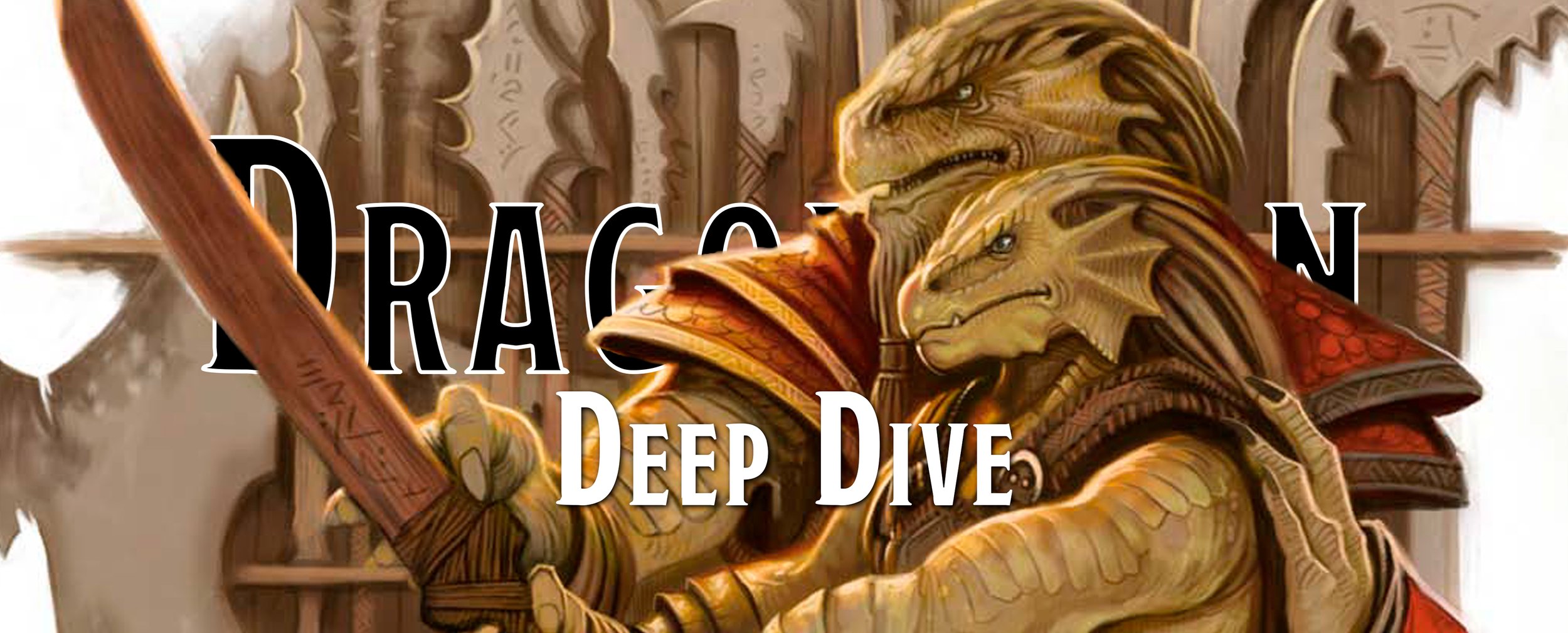Deep Dive - The Tiefling
Used to the sideways stares and disapproving frowns they see from other humanoids, Tieflings barely acknowledge the existence of others. Of course, maybe all they really want is a friend, but instead, they are dying on the inside as more people turn against them thanks to vicious rumors and gross assumptions. Can we honestly blame Tieflings for having a few evil thoughts now and then? Especially when all they want to be is left alone from the stares and rude gestures that follow them.
There’s more to this race than just the mistakes of their ancestors, as many have used their infernal powers to become powerful forces of good… and evil.
2e - Tiefling
Climate/Terrain: Abyss
Frequency: Uncommon
Organization: Solitary or Pack
Activity Cycle: Any
Diet: Carnivore
Intelligence: Very (11-12)
Treasure: C, Q, P
Alignment: Any Neutral or Evil
No. Appearing: 1 (5-8)
Armor Class: 4 (10)
Movement: 12
Hit Dice: 4+3
THAC0: 15
No. of Attacks: 1 or by weapon
Damage/Attack: 1 - 3 or by weapon
Special Attacks: Spells, poison
Special Defenses: Immunities
Magic Resistance: See Below
Size: M (6’ tall)
Morale: Steady (11-12)
XP Value: 650
Planescape Campaign Setting, 1994 TSR Inc.
The Tiefling first appears in the Planescape Campaign Setting (1994) where it is introduced as a planar playable character race, it then appears in the Planescape Monstrous Compendium Appendix 1 (1994) where they are shown off as a monster. The campaign setting only offers a brief look at playing as a Tiefling while the Monstrous Compendium offers greater insights into their ecology. Since they are offered as a playable race, their lore doesn’t immediately shift to how much they like eating humanoid flesh, though they are carnivores and eat raw meat, bones, marrow, gristle, and more. If they are unable to find raw meat, and we assume at this point that they’ve eaten their allies already, they’ll tide themselves over on ashes, coal, and other mineral matter.
This strange diet brings us to what exactly these creatures are. They aren’t demons or devils, and they don’t take kindly to being mistaken for one either. They are, instead, plane-touched and the offspring of the planes, making them as varied as the places in the Outer Planes can be. They are often orphans and are the children of humans and the horrible inhabitants of the Outer Planes, like fiends but could also be other creatures. It's hard to describe what their society is like because, quite honestly, they don't have one. No matter where they are on the planes, they are outcasts. Even the lowers planes, like the Abyss or the Nine Hells, have banished them, which should tell you what a horrible reputation they have.
Planescape Monstrous Compendium Appendix 1, 1994 TSR Inc.
Tieflings are superficially human, but that's probably only because of their height and weight, considering a Tiefling could have small horns, pointed ears, scales, or a cloven hoof. We don't blame them for being quick to anger and always thinking people are out to get them because they are discriminated against constantly. When common sayings are “If there’s blame, find a Tiefling” or “If a Tiefling didn’t do it, he was just pressed for time”, we can understand why Tieflings spend most of their life pissed off. Luckily, not all Tiefling are evil or conniving as good Tieflings do exist, they just have to work twice as hard to show others that not all of them are thieves.
If you are hoping to play as a Tiefling, well you are in luck. They are one of the three new races in the Planescape Campaign Setting along with the githzerai and the bariaur, a type of goat-centaur. Tiefling basics are that they get a bonus to their Intelligence and Charisma while suffering a penalty to their Strength and Wisdom. If you are wondering what class you should pick, they make good fighters, rangers, wizards, priests, and bards, and they excel at being thieves. For those that have never played 2e, it’s important to understand that races had class level limitations and could never exceed their class level limitation unless through powerful magic or magic item. For the Tiefling, they could reach 12th level as a priest, 14th as a fighter, 16th as a wizard, and 17th as a rogue. In addition, Tieflings get infravision and can cast the darkness spell once per day, so they have a few tricks up their sleeve if they get backed into a corner.
The Planewalker’s Handbook, 1996 TSR Inc.
The Tiefling appears in quite a few more places in this edition, with the next being in The Planewalker's Handbook (1996) where they are still shunned by all others. Since so many creatures despise Tieflings, this has caused them to be rather self-sufficient and masters of their own fate. They are willing to take risks and are rarely ever dependent on anyone other than themselves. Since they all are so different and unique, as no two Tieflings are ever the same, there is a large table that the player can roll on four times to randomly determine what powers they might have like resistance to certain elemental damages, different spells they could cast, better infravision, or bonuses against spells. There is even a table to help determine what strange physical features you might have, as well as the side effects of those features, like how your very touch can inflict 1 point of fire damage because you are so hot.
Dragon #235, November 1996 TSR Inc.
The article Planar Heroes in Dragon #235 (November 1996) by Ed Bonny details the Tiefling skills and powers rules for the Planescape setting. This is another way of creating your unique plane-touched character by allowing you to purchase different abilities at character creation, and you can increase how many points you have by taking on flaws. There are a wide variety of abilities to choose from, like being able to cast certain spells from your devil and demon ancestors or giving yourself resistance or immunity to certain elemental damage types. The flaws and weaknesses a Tiefling could take include becoming vulnerable to holy water or getting debuffs while in the Upper Planes due to how evil-aligned they are.
Dragon #235, November 1996 TSR Inc.
The last bit of information we are given shows up in Faces of Evil - The Fiends (1997) where Tieflings are written about by one of their very own, a Tiefling known as Enkillo the Sly. Enkillo goes over the major parts of being a Tiefling, as well as stating that having fiendish blood is quite a boon despite what everyone thinks. It might even be better to think of Tieflings as tainted by their mortal half as it makes them a bit more vulnerable than their fiendish ancestors. Tieflings are, by and large, used to being loners and never making true friends, even among themselves. They know that they can only rely on themselves and that they only have one shot in securing their own power, fame, and wealth before they get put in the dead book.
3e/3.5e - Tiefling (Planetouched)
Tiefling, 1st Level Warrior / Medium Outsider (Native)
Hit Dice: 1d8 + 1 (5 hp)
Initiative: +1
Speed: 30 ft. (6 squares)
Armor Class: 15 (+1 Dex, +3 studded leather, +1 light shield), touch 11, flat-footed 14)
Base Attack/Grapple: +1/+2
Attack: Rapier +3 melee (1d6+1/18–20) or light crossbow +2 ranged (1d8/19–20)
Full Attack: Rapier +3 melee (1d6+1/18–20) or light crossbow +2 ranged (1d8/19–20)
Space/Reach: 5 ft./5 ft.
Special Attacks: Darkness
Special Qualities: Darkvision 60 ft., resistance to cold 5, electricity 5, and fire 5
Saves: Fort +3, Ref +1, Will -1
Abilities: Str 13, Dex 13, Con 12, Int 12, Wis 9, Cha 6
Skills: Bluff +4, Hide +5, Move Silently +1, Sleight of Hand +1
Feats: Weapon Focus (rapier)
Climate/Terrain: Temperate plains
Organization: Solitary, pair, or gang (3–4)
Challenge Rating: 1/2
Treasure: Standard
Alignment: Usually evil
Advancement: By character class
Level Adjustment: +1
Monster Manual, 2000 WotC
The Tiefling is introduced in the Monster Manual (2000/2003) with a short description that is equal measures brutal and unfair to our friend the Tiefling. They are described as sneaky and untrustworthy in the first sentence, with only a few being able to suppress their inherent nature. Whenever they deal with other races and creatures, regardless if they are haggling for a better price or thick in combat, they only use devious tactics. They rarely make their true heritage known, instead they hide distinguishing markings, and if they have an appearance that can’t be hidden, they stick to the shadows and operate as thieves, assassins, or spies.
Unfortunately for the Tiefling, they often are forced into a life of crime which is no surprise why their favorite class is rogue and their statistics lend themselves to it. They get bonuses to lie and to sneak about, they get boosts to their Dexterity and Intelligence, but this edition sticks them with a penalty to their Charisma. In addition, they can cast the darkness spell once per day and gain resistance to cold, electricity, and fire.
Forgotten Realms Campaign Setting, 2001 WotC
It’s not until the Forgotten Realms Campaign Setting (2001) that we are given player character options for playing as a Tiefling, but before the edgelords rejoice, it comes with some penalties to be aware of. In 3rd edition, playing as a Tiefling makes you inherently more powerful than if you choose to be just a plain human or dwarf, so much so that you are permanently behind a class level in play. This simply means that if your DM tells the group to all make 3rd level characters, well, you get to be a 2nd level rogue if you go with Tiefling as your race. What do you get for this rather big debuff? Well, darkvision, a bonus to Dexterity and Intelligence, a penalty to Charisma, resistance to cold, fire, and electricity, the ability to cast the darkness spell once per day, and a bonus to all Bluff and Hide checks you make. Is the trade-off worth it? Perhaps not, but you are considered an Outsider and not a Humanoid, meaning that hold person and similar spells won’t affect you… so that’s pretty nice… you also get to be super edgy and that’s priceless!
Monsters of Fearun, 2001 WotC
If you’ve ever wondered what happens if you were a Tiefling, but you were descended from elves or orcs, look no further than Monsters of Fearun (2001) which introduces the Fey’ri and the Tanarukk. The Fey’ri is what happens when the Lower Planes get down with some elves, creating creatures that appear as tall and noble elves with fiendish traits like bat wings or pointed tails. Tanarukk are the offshoots of orcs and fiends, brutish and mean, they were bred solely as a steady supply of soldiers for demons. Each of these creatures are quite similar to Tieflings, but they gain additional powers based on their elven and orcish ancestors.
Races of Fearun, 2003 WotC
If you were interested in playing as one of them, all you have to do is wait until the release of Races of Fearun (2003) which has both of them as player character options. Fey’ri are often sorcerers and gain a bonus to their Dexterity and Intelligence and a penalty to their Constitution. While the sorcerer does rely on Charisma in this edition, we suppose that not every Sorcerer needs an 18 in Charisma when they begin their adventuring career. In addition, they lose their ability to cast darkness but can instead cast alter self at will to assume any humanoid form of their choice. The Tanarukk, on the other hand, are given a big boost to Strength and Dexterity but take a big hit to their Wisdom and Charisma. They are often barbarians, and while they lack any spells they can innately cast, they get a boost to their armor class and a lot of additional hit points and damage. If you hope to play either of these two, it’s going to come at a steep price with the Fey’ri counting as 2nd level and the Tanarukk counting as 3rd level characters before you even give them a class.
Races of Fearun, 2003 WotC
Maybe you aren’t interested in simply being a different type of Tiefling, but being the best Tiefling that you can be. You’re in luck as Unearthed Arcana (2004) provides the Tiefling paragon path. This paragon path acts as a three-level class that Tieflings can take to show off how Tiefling they are, giving them more uses of their darkness spell, increasing their bonuses on Bluff and Hide checks, getting a boost to their Dexterity, and a few other small boosts to make such a multiclass worth it. These paragons of Tiefling blood are seen as the greatest among the Tieflings and, unfortunately, slip into some of the stereotypes that Tieflings are known for. Almost all Tiefling paragons are evil, they avoid good-aligned deities and their worshipers, and prefer to avoid getting too close to anyone unless they are planning on betraying them soon.
Races of Destiny, 2004 WotC
The Tiefling’s player character statistics appear again in the Planar Handbook (2004) and Races of Destiny (2004) with no mechanical changes. What they do get is that their society is further refined and a few details slip through the cracks. If the Tieflings do decide to worship a deity, it’s typically going to be some of the cruelest out there, like Vecna or Erythnul, the god of Slaughter. Sure, a neutral rogue Tiefling could pray to Olidammra, the god of thieves, but the pull of being evil is usually too strong.
In addition, they now gain a nemesis in the form of the aasimar race. Those goody two shoes are the opposites of our beloved Tiefling. Apparently, the aasimar don’t appreciate the fact that you can’t trust a Tiefling as far as you can throw them, and the Tiefling don’t like the fact that the aasimar keep killing them and telling their gods all about how evil Tieflings are.
4e - Tiefling Heretic
Level 6 Artillery
Medium natural humanoid / XP 250
Initiative +8 / Senses Perception +6; low-light vision
HP 60; Bloodied 30
AC 20; Fortitude 17, Reflex 18, Will 18
Resist 11 fire
Speed 6
Dagger (standard; at-will) ✦ Weapon +10 vs. AC (+11 against a bloodied target); 1d4 + 2 damage
Balefire (standard; at-will) ✦ Fire Ranged 10; +9 vs. Reflex (+10 against a bloodied target); 1d8 + 5 fire damage, and ongoing 5 fire damage (save ends).
Serpent Curse (standard; encounter) ✦ Illusion, Psychic Ranged 10; illusory snakes appear and attack the target; +9 vs. Will (+10 against a bloodied target); 1d6 + 5 psychic damage, and ongoing 5 psychic damage (save ends).
Cloak of Escape (immediate reaction, when the tiefling heretic is hit by a melee attack; at-will) ✦ Teleportation The tiefling heretic teleports 5 squares.
Infernal Wrath (minor; encounter) The tiefling heretic gains a +1 power bonus to its next attack roll against an enemy that hit it since the tiefling heretic’s last turn. If the attack hits and deals damage, the tiefling heretic deals an extra 5 damage.
Alignment Any / Languages Common
Skills Bluff +15, Insight +11, Stealth +15
Str 15 (+5) Dex 20 (+8) Wis 16 (+6) Con 18 (+17) Int 13 (+4) Cha 20 (+8)
Equipment dagger
Player’s Handbook, 2008 WotC
The Tiefling undergoes some significant changes with their reveal in the Player’s Handbook (2008). They are now a core race, which means you no longer have to choose between higher class levels or an edgy character race! This iteration of the Tiefling brings with it several changes, but don’t worry, all Tieflings are still struggling with the evil inside of them.
The Tiefling first begin, not as horrific humanoids, but rather simple humans ruled over by a group of power-hungry nobles in the kingdom of Bael Turath. They are looking to further their domination of the world and make a bargain with some unnamed infernal power to gain dark powers. This helped them out for quite a bit before their kingdom eventually fell, leaving their empire scattered and broken. What remained were the Tieflings, the descendants of those human nobles who were cursed with infernal blood that can’t be diluted out of their descendants.
Of course, as you probably guess, this is why and how the Tiefling is mistrusted by other races and is so lonely. For most Tieflings, they couldn’t care less about a deal made thousands of years ago, but rather are trying to live their life how they want. Due to their infernal heritage, they typically avoid anything to do with deities and the divine, simply trusting in themselves than a god to help them out of any tricky situations they get into. While most Tieflings are standoffish, they do eventually begin trusting others so long as their companions can prove themselves to not be the literal worst who hate Tieflings just because they got horns and a tail.
Player’s Handbook, 2008 WotC
For those wanting to play as a Tiefling, things shape up a bit differently for them. No longer do they take a penalty to their Charisma, which before was simply given to them because they looked evil, but now they get a boost to it! It’s about time that Dungeons & Dragons recognize that Charisma isn’t about your outer looks but rather your force of personality and guile, that it’s the inner beauty that counts. In addition, they get resistance to fire, they lose their darkvision in exchange for low-light vision, and they get a new ability known as Infernal Wrath. This ability grants them a bonus to attack and damage when an enemy would dare to strike them, allowing the Tiefling to put them back in their place with pain… lots of pain.
Monster Manual, 2008 WotC
The Tiefling aren’t just creatures to be played as, you can also encounter them in the Monster Manual (2008) which introduces two versions of them, the Heretic and the Darkblade. The Heretic is the more of a devilish Tiefling who can curse you with mental anguish and then shoot Balefire at you round after round until they are forced to flee for their lives as they hate getting too close to their enemies. As for the Darkblade, they are powerful rogues who sneak through the shadows before popping up and stabbing you in the back with a poisoned shortsword. It’s nice to see that the tradition of them being conniving, sneaky thieves is still alive and stabbing you in the back.
Dragon #387, May 2010 WoTC
Luckily for our Tieflings, they get a bit of action in this edition starting with Dragon #387 (May 2010) in the article Winning Races: Tiefling. This article features new feats that came about thanks to the fall of the kingdom of Bael Turath. This manifests as a power known as the Gaze of Ruin which allows the Tiefling to target an object during an encounter and bring about a curse on it, either weakening it in the fight, if it’s a weapon, or imposing a penalty on the armor class it provides if it’s armor. As you get more powerful, you can further enhance this ability, imposing this curse on objects for longer periods, on creatures who wield items you curse, and you can target multiple objects and creatures with your curse.
If you are looking for even more Tiefling goodness, then look no further than the Player Handbook Races: Tiefling (2010) and the Heroes of the Forgotten Kingdoms (2010) which both feature more information on the Tiefling and the history of Bael Turath. The Handbook features not just the history and lives of Tieflings, but new Tiefling specific weapons and paragon paths that help separate them from the other races who just are as devilishly fiendish as they are. In Heroes of the Forgotten Kingdoms, it features ways to help new players roleplay as a Tiefling, helping those players unlock the inner pain that comes from a Tiefling’s tortured and lonely existence.
Player Handbook Races: Tiefling, 2010 WotC
5e - Tiefling
Traits: Tieflings share certain racial traits as a result of their infernal descent.
Ability Score Increase: Your Intelligence score increases by 1, and your Charisma score increases by 2.
Age: Tieflings mature at the same rate as humans but live a few years longer.
Alignment: Tieflings might not have an innate tendency toward evil, but many of them end up there. Evil or not, an independent nature inclines many tieflings toward a chaotic alignment.
Size: Tieflings are about the same size and build as humans. Your size is Medium.
Speed: Your base walking speed is 30 feet.
Darkvision: Thanks to your infernal heritage, you have superior vision in dark and dim conditions. You can see in dim light within 60 feet of you as if it were bright light, and in darkness as if it were dim light. You can’t discern color in darkness, only shades of gray.
Hellish Resistance: You have resistance to fire damage.
Infernal Legacy: You know the thaumaturgy cantrip. When you reach 3rd level, you can cast the hellish rebuke spell as a 2nd-level spell once with this trait and regain the ability to do so when you finish a long rest. When you reach 5th level, you can cast the darkness spell once with this trait and regain the ability to do so when you finish a long rest. Charisma is your spellcasting ability for these spells.
Languages: You can speak, read, and write Common and Infernal.
Player’s Handbook, 2014 WotC
Now a core race, the Tiefling sits in its proper place among dwarves, elves, and gnomes in the 5th edition Player's Handbook (2014). They don’t even appear as a monster in the Monster Manual, even though the likes of the drow and duergar do, which probably comes as a breath of fresh air… or they hate it as it takes away their edgy points.
Their lore is all about the infernal bloodline that they come from. No longer is it some great empire that crumpled, but rather is the result of humans making deals with devils, more specifically Asmodeus, the overlord of the Nine Hells. We guess if you are going to make a deal to completely screw over hundreds of future generations, you may as well do it right and get the almost god-like ruler of hell to come up and sign the contract.
Tieflings remain mistrustful of others and are fiercely independent. If they do end up trusting someone, like say a party of three other adventurers who are trying to save the world with them, then they become fast friends for life, their loyalty never wavering. Of course, you might think you are best friends with a Tiefling and they could be lying through their teeth as, if you hope to play as one of them, they get a bonus to their Intelligence and Charisma score. This gives them a strong and cunning mind, perfect for those who make foolish choices and create warlock pacts with devils to really hone in on being as devilish as possible.
Tieflings keep almost everything they had from before, including their resistance to fire, and even get the return of their darkvision. While, on the surface, it appears to lose its fun Infernal Wrath trait from 4th edition, it instead gains additional spells, like hellish rebuke that simulates a portion of that ability while also giving them access to their darkness spell and a new cantrip, thaumaturgy.
Sword Coast Adventurer’s Guide, 2015 WotC
Of course, maybe the same old Tiefling just doesn’t do it for you anymore and you want a few more options to drop on your unsuspecting party. The Sword Coast Adventurer’s Guide (2015) provides a look at a few variant qualities that a Tiefling could have. You might choose to go Feral and ditch your boost to Charisma in exchange for Dexterity, giving you that perfect sneaky rogue Tiefling build. Or perhaps you’d like to switch out a few spells that you get access to, or maybe you’d rather have wings and a fly speed?
Not to finish so early, Tieflings also make an appearance in Mordenkainen’s Tome of Foes (2018). There is a section on the Blood War, which is the perfect time to introduce additional Tiefling subraces, one for each of the major devils living in the Nine Hells so that none feel left out, and direct their wrath towards Mordenkainen himself. This edition really points out that Tieflings are solely those born with devilish blood, leaving those poor demons out in the cold with no children to call their own. The new subraces showcase descendants from Baalzebul, Dispater, Fierna, Glasya, Levistus, Mammon, Mephistopheles, and Zariel; each with a boost to Charisma and another ability score specific to a Lord of the Nine.
Mordenkainen’s Tome of Foes, 2018 WotC
The Tiefling has been a creature of misfortune and mistrust. Touched by the foul entities of the Lower Planes, misunderstandings abound of their powers and dispositions, until it becomes a self-fulfilling prophecy. While the inhabitants of Dungeons & Dragons might not like Tieflings, players everywhere have such a fondness for them that they quickly became a permanent fixture in the Player’s Handbook.
If you enjoy our Deep Dive series, consider
supporting us on Patreon and following us on Twitter!


